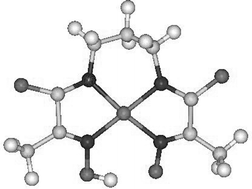In vitro and in vivo stability investigations of Cu(ii), Zn(ii), Ca(ii) and Gd(iii) complexes with N,N′-bis(2-hydroxyiminopropionyl) propane-1,3-diamine†
Abstract
Formation constants of copper(II), zinc(II), calcium(II) and gadolinium(III) with

* Corresponding authors
a Department of Chemistry, University of Transkei, Private Bag X1, Unitra, Umtata, 5117, South Africa
b
Department of Chemistry, University of Cape Town, Private Bag, Rondebosch 7700, South Africa
E-mail:
jackson@science.uct.ac.za
Fax: +27 021 6897499
Tel: +27 021 6502531
Formation constants of copper(II), zinc(II), calcium(II) and gadolinium(III) with

 Please wait while we load your content...
Something went wrong. Try again?
Please wait while we load your content...
Something went wrong. Try again?
E. T. Nomkoko, G. E. Jackson and B. S. Nakani, Dalton Trans., 2004, 1432 DOI: 10.1039/B316698H
To request permission to reproduce material from this article, please go to the Copyright Clearance Center request page.
If you are an author contributing to an RSC publication, you do not need to request permission provided correct acknowledgement is given.
If you are the author of this article, you do not need to request permission to reproduce figures and diagrams provided correct acknowledgement is given. If you want to reproduce the whole article in a third-party publication (excluding your thesis/dissertation for which permission is not required) please go to the Copyright Clearance Center request page.
Read more about how to correctly acknowledge RSC content.
 Fetching data from CrossRef.
Fetching data from CrossRef.
This may take some time to load.
Loading related content
